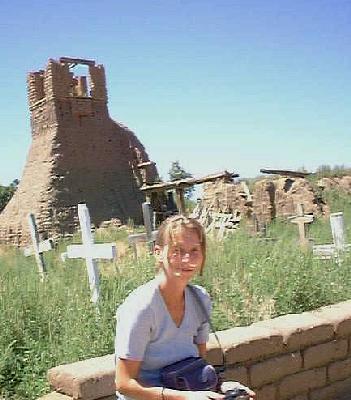
Taos, New Mexico

South House (Hlaukwima), Taos Pueblo
Thursday 12th August 1999
About an hour to the north of Santa Fe is the town and pueblo of Taos. Like Santa Fe, the town is mainly built of adobe and is the centre of a major ski area in the surrounding mountains, but the main attraction is the amazing Taos Pueblo.
To the south of the town is the old Ranchos de Taos, now largely derelict, and the San Francisco de Asis church, a beautiful 16th century Spanish adobe church, which from certain angles with its massive buttresses looks more like a fortification than a place of worship. The adobe facings of the wall contain more straw than in other adobe buildings, making the church shimmer in the sunshine, creating an even more impressive spectacle.

Veronika and Fergus taking it easy at the San Francisco de Asis church
Next to the church lie the ruins of an old ranch. The crumbling walls give an insight into the methods of construction of adobe buildings, and the spot is picturesque enough to attract amateur painters and sketchers. The church is still in use today as a parish church for Taos, and makes for a cool refuge from the heat of the midday sun - it was certainly very hot when we visited.

Ruins of Ranchos de Taos, New Mexico
A few miles to the north of the town of Taos lies the Taos Pueblo, the largest existing multi-storey pueblo structure in the United States. It was originally built around 1450, and has been continuously inhabited ever since, making it one of the oldest villages in the country. It is well worth a visit, although at $10 each per person, plus $10 for the strictly enforced camera permits, it is not cheap. It is also still inhabited by native Americans, and so requires a certain amount of sensitivity and respect which is sometimes sadly lacking in tourists, although it seemed to be well in evidence while we were there.

The North House (Hlauuma)
The pueblo is divided in two by the Red Willow Creek, which flows down from the Blue Lake, sacred to the Taos Pueblo people, high up in the mountains which surround the pueblo. The river is still the only source of drinking water for the inhabitants of the pueblo. It was only in 1996 that the Taos people had the last of their land returned to them, and one of the things that impressed me most was that, despite all that has happened to them since the arrival of the Europeans, the local people have managed to preserve their traditional culture to an extraordinary extent. Around 90% of the people here are nominally Catholic, although as our guide pointed out, about 90% of them also practice their traditional religions.
The buildings of the pueblo range from one to five stories high. Traditionally, the only access to the buildings was by the roof and ladders, which allowed for defence from raids by other tribes. The whole site was originally surrounded by a wall that was twelve feet high and five or six feet in width, with four watchtowers which are no longer there.

Veronika in front of the ruins of the old San Geronimo Church
The first church on the pueblo was built by Spanish missionaries in 1619. It was destroyed during the Pueblo revolt in 1680, which was planned from Taos, and was rebuilt in 1706. In 1847, US Territorial Governor Charles Bent was killed, and the US Army attacked Taos Pueblo in retaliation. Many elderly women, children and men barricaded themselves in the church to avoid the army, which bombarded the church with cannon, killing 150 Indians in the process. The ruined church was never rebuilt, and the courtyard became the graveyard for the pueblo and is now off-limits to tourists. A new Chapel of St Jerome was built nearby in 1850. The decorations of the chapel show a mix of Catholic and native styles and symbols - the central figure of Mary is surrounded by representations of corn, which was of extreme religious significance to the Pueblans, and the various figures are dressed in different coloured clothing depending on the time of year to represent the seasons.

An orno and kiva at the Taos Pueblo
The people of the pueblo cook using round adobe ovens called ornos. A fire is lit using cedar wood, and once it is reduced to coals, the ashes are removed, the food is placed in and the door is closed. The adobe acts as an insulating layer, and the residual heat is sufficient to cook the food. The kivas on the site are closed to tourists as they are still in use
Previous | Travel index | Family history | Romany | Main index